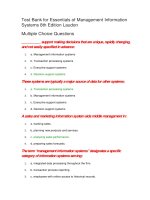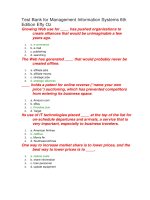Enterprise manage information systems 6th by laudon ch04
Bạn đang xem bản rút gọn của tài liệu. Xem và tải ngay bản đầy đủ của tài liệu tại đây (359.16 KB, 39 trang )
Chapter 4
Essentials of Management Information Systems, 6e
Chapter 4 The Digital Firm: Electronic Business and Electronic Commerce
The Digital Firm: Electronic Business
and Electronic Commerce
4.1
© 2005 by Prentice Hall
Essentials of Management Information Systems, 6e
Chapter 4 The Digital Firm: Electronic Business and Electronic Commerce
Objectives
1. How has Internet technology changed value
propositions and business models?
2. What is electronic commerce? How has
electronic commerce changed consumer
retailing and business-to-business transactions?
3. What are the principal payment systems for
electronic commerce?
4.2
© 2005 by Prentice Hall
Essentials of Management Information Systems, 6e
Chapter 4 The Digital Firm: Electronic Business and Electronic Commerce
Objectives
4. How can Internet technology facilitate
management and coordination of internal and
interorganizational business processes?
5. What are the major managerial and
organizational challenges posed by electronic
business and electronic commerce?
4.3
© 2005 by Prentice Hall
Essentials of Management Information Systems, 6e
Chapter 4 The Digital Firm: Electronic Business and Electronic Commerce
Management Challenges
1. Digitally integrating the enterprise requires a
complete change of mind-set.
2. Finding a successful Internet business model.
4.4
© 2005 by Prentice Hall
Essentials of Management Information Systems, 6e
Chapter 4 The Digital Firm: Electronic Business and Electronic Commerce
Electronic Business, Electronic Commerce, and the Emerging Digital Firm
Internet Technology and the Digital Firm
The Internet
• Rapidly becoming infrastructure of choice
• Universal, easy-to-use set of technologies and
standards
• Web sites available 24/7
• Extended distribution channels
• Reduced transaction costs
• Reduced network and coordination costs
4.5
© 2005 by Prentice Hall
Essentials of Management Information Systems, 6e
Chapter 4 The Digital Firm: Electronic Business and Electronic Commerce
Electronic Business, Electronic Commerce, and the Emerging Digital Firm
New Business Models and Value Propositions
•
Past: Information about products and services bundled with their physical value chain
•
Today: The Internet has unbundled information from traditional value chain, creating new business models
4.6
© 2005 by Prentice Hall
Essentials of Management Information Systems, 6e
Chapter 4 The Digital Firm: Electronic Business and Electronic Commerce
Electronic Business, Electronic Commerce, and the Emerging Digital Firm
New Business Models and Value Propositions
Information Asymmetry
• One party has more information essential to the
transaction than the other party
• The Internet shrinks information asymmetry
4.7
© 2005 by Prentice Hall
Essentials of Management Information Systems, 6e
Chapter 4 The Digital Firm: Electronic Business and Electronic Commerce
Electronic Business, Electronic Commerce, and the Emerging Digital Firm
New Business Models and Value Propositions
Richness and Reach
• Richness: depth and detail of information
• Reach: how many people a business can connect
with; how many products offered those people
• Internet allows much richer communication with
farther reach
4.8
© 2005 by Prentice Hall
Essentials of Management Information Systems, 6e
Chapter 4 The Digital Firm: Electronic Business and Electronic Commerce
Electronic Business, Electronic Commerce, and the Emerging Digital Firm
The changing economics of information
Figure 4-1
4.9
© 2005 by Prentice Hall
Essentials of Management Information Systems, 6e
Chapter 4 The Digital Firm: Electronic Business and Electronic Commerce
Electronic Business, Electronic Commerce, and the Emerging Digital Firm
New Business Models and Value Propositions
Internet Business Models
• Virtual storefront: Sells physical products directly
to consumers or businesses.
• Information broker: Provides product pricing and
availability information; generates revenue from
advertising or directing buyers to sellers.
• Transaction Broker: Processes online sales
transactions for fee.
4.10
© 2005 by Prentice Hall
Essentials of Management Information Systems, 6e
Chapter 4 The Digital Firm: Electronic Business and Electronic Commerce
Electronic Business, Electronic Commerce, and the Emerging Digital Firm
New Business Models and Value Propositions
Internet Business Models
• Online Marketplace: Provides digital environment
where buyers and sellers meet
• Content Provider: Provides digital content, such as
news; revenue from fees or advertising sales
• Online Service Provider: Provides connectivity;
revenue from fees, advertising, or marketing
information
4.11
© 2005 by Prentice Hall
Essentials of Management Information Systems, 6e
Chapter 4 The Digital Firm: Electronic Business and Electronic Commerce
Electronic Business, Electronic Commerce, and the Emerging Digital Firm
New Business Models and Value Propositions
Internet Business Models (cont.)
• Virtual Community: Provides online meeting place
for people of similar interests
• Portal: Provides initial point of entry to the Web,
along with specialized content and services
• Syndicator: aggregates content or applications to
resell as package to third-party Web sites
4.12
© 2005 by Prentice Hall
Essentials of Management Information Systems, 6e
Chapter 4 The Digital Firm: Electronic Business and Electronic Commerce
Electronic Commerce
Categories of Electronic Commerce
• Business-to-consumer (B2C): Retailing products
and services to individual shoppers
• Business-to-business (B2B): Sales of goods and
services among businesses
• Consumer-to-consumer (C2C): Consumers selling
directly to consumers
4.13
© 2005 by Prentice Hall
Essentials of Management Information Systems, 6e
Chapter 4 The Digital Firm: Electronic Business and Electronic Commerce
Electronic Commerce
Customer-Centered Retailing
Direct Sales Over the Web
• Disintermediation: Removal of intermediary steps
in a value chain, selling directly to consumers,
significantly lowers purchase transaction costs
• Reintermediation: Shifting intermediary function
in a value chain to a new source, such as “service
hubs”
4.14
© 2005 by Prentice Hall
Essentials of Management Information Systems, 6e
Chapter 4 The Digital Firm: Electronic Business and Electronic Commerce
Electronic Commerce
The benefits of disintermediation to the consumer
Figure 4-2
4.15
© 2005 by Prentice Hall
Essentials of Management Information Systems, 6e
Chapter 4 The Digital Firm: Electronic Business and Electronic Commerce
Electronic Commerce
Customer-Centered Retailing
Interactive Marketing and Presentation
• Collection of customer information using Web site
auditing tools less expensive than surveys and
focus groups
• Web personalization technology customizes
content on Web site to individual’s profile and
purchase history
• Web sites and marketing shorten sales cycle and
reduce time spent in customer education
4.16
© 2005 by Prentice Hall
Essentials of Management Information Systems, 6e
Chapter 4 The Digital Firm: Electronic Business and Electronic Commerce
Electronic Commerce
Web site personalization
Figure 4-3
4.17
© 2005 by Prentice Hall
Essentials of Management Information Systems, 6e
Chapter 4 The Digital Firm: Electronic Business and Electronic Commerce
Electronic Commerce
Customer-Centered Retailing
Customer Self-Service
• Web-based responses to customer questions cost a
fraction of telephone costs for live customer
service representation
• Web-based customer self-service applications,
such as airline flight information sites
• Traditional, phone-based customer call centers
being integrated with Web
4.18
© 2005 by Prentice Hall
Essentials of Management Information Systems, 6e
Chapter 4 The Digital Firm: Electronic Business and Electronic Commerce
Electronic Commerce
Business-to-Business Electronic Commerce
•
Web, Internet streamlining procurement process
•
E-procurement eliminates inefficient, paperbased processes
•
Selling through Web sites, private industrial
networks, or Net marketplaces
4.19
© 2005 by Prentice Hall
Essentials of Management Information Systems, 6e
Chapter 4 The Digital Firm: Electronic Business and Electronic Commerce
Electronic Commerce
Window on Technology
Lightnin Lights Up with the Internet
•
What are the benefits of using Web-based order
configuration software?
•
How does this system provide value to Lightnin
and its customers?
4.20
© 2005 by Prentice Hall
Essentials of Management Information Systems, 6e
Chapter 4 The Digital Firm: Electronic Business and Electronic Commerce
Electronic Commerce
Before-after diagram of changes in Lightnin’s ordering process
Figure 4-4
4.21
© 2005 by Prentice Hall
Essentials of Management Information Systems, 6e
Chapter 4 The Digital Firm: Electronic Business and Electronic Commerce
Electronic Commerce
Business-to-Business Electronic Commerce
Private Industrial Network
•
•
•
4.22
Private exchange; typically consists of large firm
using extranet to link to its suppliers and business
partners
Permits firm and partners to share product design,
development, marketing, scheduling, inventory
management, and unstructured communication
Fastest-growing type of B2B commerce
© 2005 by Prentice Hall
Essentials of Management Information Systems, 6e
Chapter 4 The Digital Firm: Electronic Business and Electronic Commerce
Electronic Commerce
A private industrial network
Figure 4-5
4.23
© 2005 by Prentice Hall
Essentials of Management Information Systems, 6e
Chapter 4 The Digital Firm: Electronic Business and Electronic Commerce
Electronic Commerce
Business-to-Business Electronic Commerce
Net Marketplace
•
•
•
4.24
E-hub; provides single Internet-based
marketplace for many different buyers and
sellers
Industry owned or independent intermediaries
Transaction oriented; generates revenue from
purchase and sales transactions and other
services
© 2005 by Prentice Hall
Essentials of Management Information Systems, 6e
Chapter 4 The Digital Firm: Electronic Business and Electronic Commerce
Electronic Commerce
A Net marketplace
Figure 4-6
4.25
© 2005 by Prentice Hall









